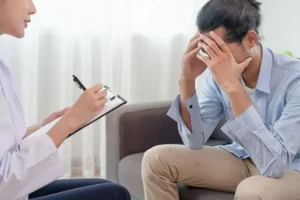In the world of mental health solutions, exposure therapy stands out as a game-changer in the fight against depression. Let’s dive into the fascinating realm of exposure therapy together. We’re not just going to talk about its principles and mechanisms – we’re going on a journey of discovery, uncovering the tangible benefits that make exposure therapy a beacon of hope for those battling depression. So, let’s get started!
Contents
What is Exposure Therapy?
Exposure therapy is like a superhero for your mind, swooping in to tackle anxiety and depression head-on. This therapeutic technique involves facing your fears in a safe and controlled environment. It’s not about avoiding the discomfort; it’s about embracing it with the guidance of a mental health professional.
Imagine it as a journey where you confront your anxiety, one step at a time, gaining strength and resilience along the way. By directly tackling the sources of distress, exposure therapy empowers individuals to rewrite their mental narratives and reclaim control over their lives.
Is It Effective In Treating Depression?
 Wondering if exposure therapy is the right ally in the fight against depression? Let’s break it down in simple terms.
Wondering if exposure therapy is the right ally in the fight against depression? Let’s break it down in simple terms.
Well, Exposure therapy initially took the spotlight in battling anxiety disorders. It was like a trusted sidekick for facing fears and overcoming anxieties. But what makes exposure therapy an effective trteatment option in treating depression is when it is combined with other treatments, especially cognitive-behavioral therapy (CBT).
Therefore, exposure therapy, when teamed up with CBT and other treatments, proves its effectiveness in reducing depressive symptoms. It’s not just about managing the blues; it’s about finding practical ways to lift the cloud of depression.
In a nutshell, exposure therapy might have started its journey in the world of anxiety, but with the right companions like CBT, it’s proven to be a valuable asset in the battle against depression. It’s like having a reliable friend who’s got your back when things get tough.
The Process of How Exposure Therapy is Delivered

Get ready for a behind-the-scenes look at how exposure therapy is delivered – it’s not a one-size-fits-all approach but a personalized journey guided by mental health professionals.
Understanding Your Fears: Exposure therapy begins with a deep dive into understanding your fears. What makes you anxious or triggers your depressive feelings? This step is like mapping out the battlefield before the heroic showdown.
Setting the Stage: Before facing fears head-on, the therapist sets the stage. This might involve discussing coping strategies, establishing a safe environment, and ensuring you’re ready for the challenges ahead.
Start Small, Go Big: The journey of exposure therapy is a gradual progression. You start small, facing less distressing situations, and gradually work your way up. It’s like training for a marathon – you build endurance over time.
Guided by a Pro: A crucial element is having a mental health professional as your guide. They provide support, encouragement, and expertise throughout the process. It’s like having a trusted navigator on a challenging but rewarding expedition.
Feedback and Adjustments: As you face your fears, constant feedback is crucial. The therapist assesses your progress, making adjustments to ensure the therapy remains tailored to your needs. It’s a collaborative effort, much like a team working together towards a common goal.
Celebrating Victories: Exposure therapy isn’t just about facing fears; it’s about celebrating victories, no matter how small. Each triumph contributes to building resilience and breaking the chains of depression.
In essence, the delivery of exposure therapy is a thoughtful, strategic process, personalized to your unique journey towards overcoming depression. With a skilled guide by your side, you’re not just confronting fears – you’re rewriting the narrative of your mental well-being.
The Benefits That You’ll See After Therapy
 Now, let’s talk about the rewards waiting for you on the other side of exposure therapy. It’s not just about facing fears; it’s about reaping the benefits of your courageous journey.
Now, let’s talk about the rewards waiting for you on the other side of exposure therapy. It’s not just about facing fears; it’s about reaping the benefits of your courageous journey.
- Reduced Anxiety and Depression: One of the primary perks is a noticeable reduction in anxiety and depressive symptoms. Exposure therapy equips you with the tools to manage and overcome the challenges that once felt overwhelming.
- Improved Coping Skills: As you progress through exposure therapy, you’ll develop enhanced coping skills. It’s like upgrading your mental toolbox, giving you practical strategies to navigate life’s difficulties.
- Increased Resilience: Facing fears head-on fosters resilience. You become better equipped to handle stressors, setbacks, and the curveballs life throws your way. It’s a transformative process that builds mental toughness.
- Enhanced Quality of Life: With reduced anxiety and depression comes an improved overall quality of life. Exposure therapy isn’t just about managing symptoms; it’s about reclaiming joy, fulfillment, and a sense of control.
- Empowerment and Self-Confidence: Every conquered fear adds a layer of empowerment and boosts self-confidence. It’s a journey of self-discovery where you realize your inner strength and capacity to overcome adversity.
- Better Relationships: As you become more adept at managing your mental health, your relationships may also benefit. Improved communication and emotional well-being contribute to healthier connections with others.
- Long-Term Positive Impact: Exposure therapy isn’t a quick fix; it’s an investment in long-term mental well-being. The benefits you gain extend beyond the therapy sessions, creating a lasting positive impact on your life.
In essence, the journey through exposure therapy brings about a cascade of positive changes that extend far beyond the initial challenges. It’s a transformative process that empowers you to not just survive but thrive in the face of depression.
Can I Do Exposure Therapy On My Own?
 Feeling empowered and ready to take charge of your mental well-being? While exposure therapy is often facilitated by professionals, there are some DIY techniques you can explore to complement your journey.
Feeling empowered and ready to take charge of your mental well-being? While exposure therapy is often facilitated by professionals, there are some DIY techniques you can explore to complement your journey.
Self-Guided Exposure Methods: Begin by identifying situations or activities that trigger your anxiety or depressive feelings. Start small and gradually expose yourself to these situations, increasing the difficulty as you become more comfortable. It’s like setting your own pace on the journey to recovery.
Journaling and Reflection: Maintain a journal to track your thoughts and emotions during exposure exercises. Reflecting on your experiences can provide valuable insights into your progress and areas that may need further attention. It’s a bit like creating a roadmap for your personal growth.
Visualization Techniques: Practice visualization by mentally confronting feared situations. This technique allows you to simulate exposure in a controlled environment. It’s akin to mentally rehearsing for the challenges you’ll face in real-life situations.
Mindfulness and Meditation: Incorporate mindfulness and meditation into your routine. These practices help you stay present, focused, and grounded. Think of it as a mental warm-up before engaging in exposure activities.
Safety Precautions: While DIY techniques can be beneficial, it’s crucial to emphasize the importance of safety precautions. Here are a few key considerations:
- Start Gradually: Begin with less distressing situations before progressing to more challenging ones.
- Know Your Limits: Be aware of your emotional state and stop if you feel overwhelmed. It’s okay to take breaks and revisit exposure exercises when you’re ready.
- Seek Professional Guidance: DIY techniques are complementary, not a replacement for professional guidance. If you find yourself struggling or if the DIY approach becomes too challenging, consider consulting with a mental health professional.
Remember, your well-being is a priority. DIY exposure techniques can be a valuable part of your journey, but they should be approached with care and mindfulness. If at any point you feel unsure or need additional support, don’t hesitate to reach out to a mental health professional for guidance.
Conclusion
In conclusion, exposure therapy emerges as a promising and effective treatment for depression, offering a dynamic and proactive approach to mental health. By understanding its principles, mechanisms, and benefits it provides, individuals can make informed decisions about incorporating exposure therapy into their treatment plans. If you are experiencing depression-related issues, Online Depression Counseling at TherapyMantra can help: Book a trial Online therapy session


